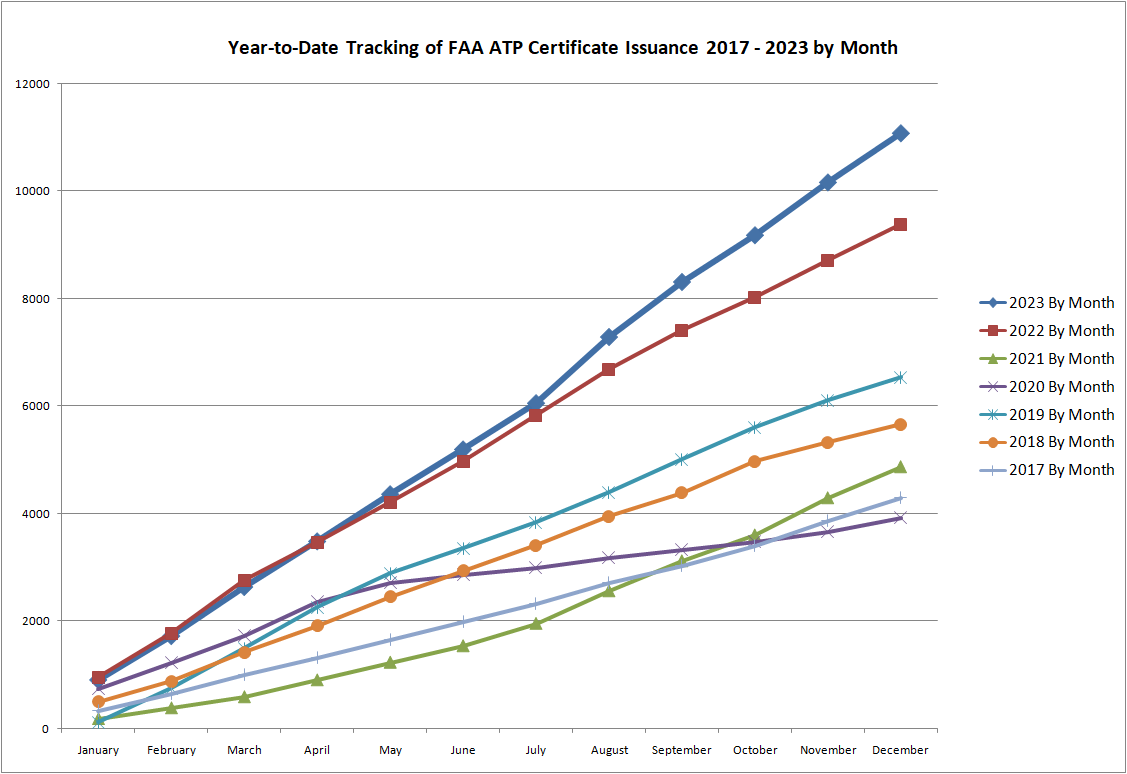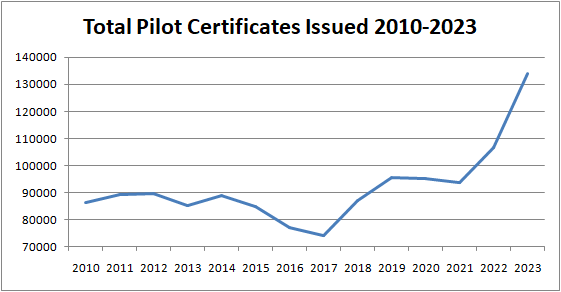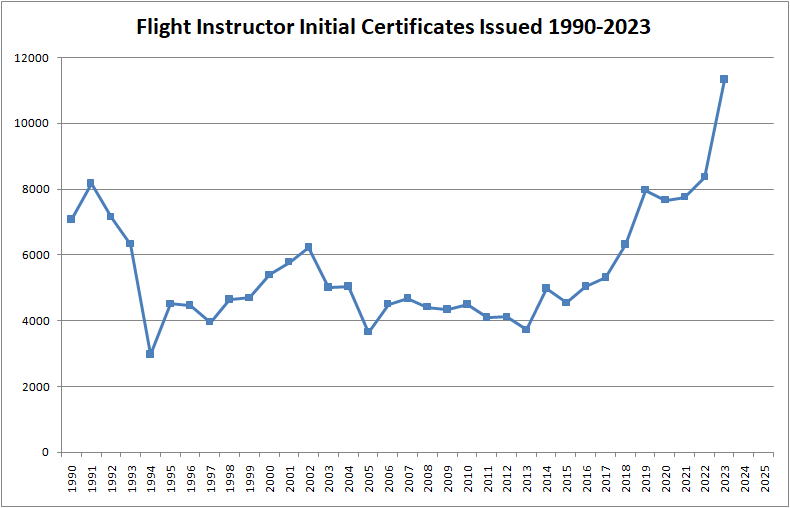For the first time since 1999, we experienced a year-to-year overall decrease in the number of holders of FAA Certificated Flight Instructor (CFI) certificates. For a long time, the average age of the holder of CFI certificate was continuing to climb in our U.S. aviation databases. This spiked, and began to turn in a more downward direction in 2017. This also appears it may be a peak point in our CFI certificates held point for the moment.
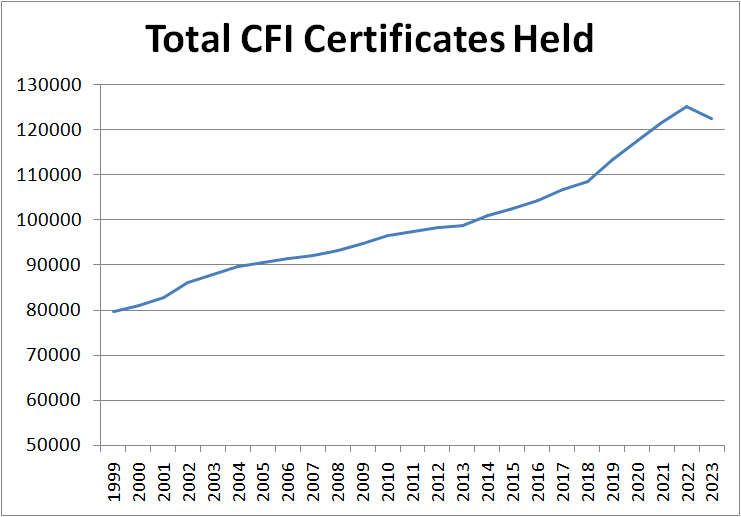
With the 2023 data, we see that we decreased from 125,075 CFI certificated holders in 2023 to 122577 at the end of 2023. This represents a small, 1.9% decrease, but it is also happening when we are at the same time increasing the number of CFI certificates issued in each year.
We can see from the graph below that we have been increasing the number of CFI certificates issued yearly in the recent past, even surpassing high points of issuance back in the early 1990s.

If we look at more detail, we can find that in 2023 we increased our CFI issuance numbers to 11,337 from what we had in 2022, 8364. This was an increase in issuance numbers of over 35%. In spite of this, we saw that overall small drop in overall numbers of CFI certificates held.
I have a theory here, and it is a simple one. We have CFIs who are simply aging out of the system. Since the CFI certificate (currently) requires the individual to renew the certificate every two years to keep it active, at some point people who are of retirement age eventually stop doing this. This seems to match with our trending up of overall CFI age for many years and now a relatively significant turn being experienced in the past few years of average CFI age.

The largest numbers of CFI certificate issuances are to younger pilots who are entering the career path, utilizing the CFI job to gain experience to make them employable for minimum experience requirements. As we certificate more of these younger CFIs each year, and as the older CFIs retire and no longer keep their certificates active, I expect that this turn in average age will continue. It also seems to indicate that we may see a continued dropoff of total CFI certificate holder numbers that will eventually stabilize at some point at a lower number.
Our baby boomer generation of pilots is aging, and retiring. As this happens, we can see some of the effects tracking in our various pilot population data points. I fully expect us to continue to see a reduction in overall CFI certificate holder numbers in upcoming years as a result.
One might ask, however, if this means we are less able to produce pilot certification due to a lower number of CFIs in our system. On the surface, this might seem a logical assumption, but it doesn’t really track like that.
The youngest of our CFI cadre still tend to provide the bulk of the training for primary certification. Most of our older CFI certificate holders are employed in other professional aviation functions, such as a corporate or airline pilot, and keep their certificates from expiring but are not actively using it on a regular basis for primary training efforts. There are exceptions to this who are engaged with the flight training industry and might be even serving as chiefs in training programs or engaged on other training sectors, but they do not comprise the majority.
In fact, each year there is another interesting data point that helps us understand the activity of our CFI cadre. This is the data point that shows how many CFIs have endorsed at least one, and I mean just one, applicant for a practical test within the year. You can see from the chart here that this is much smaller percentage of our CFI population than the overall total.
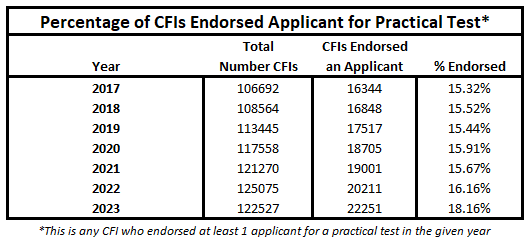
As our CFI total numbers go down, and our younger cadre of CFIs goes up, I do expect the percentage of CFIs who do endorse to increase, especially as we increase overall pilot certification efforts.
The bulk of certification training for practical test endorsement continues to be completed by under 20% of our CFI certificate holder core. Even smaller numbers of these CFIs sign off larger numbers of applicants each year (you can see some more detail on this at – How many did you sign off as a CFI in 2023? How do you compare?).
Our CFI population is one that is very transitory in terms of their highly active years. By most accounts, CFIs in heavy training volume operations are there 14-18 months over the past few years before flowing to employment in other professional pilotage positions. Should airline hiring rates decrease, this typically will extend their time service as a CFI. In either case, our more senior CFI certificate holders are not as active, are aging, and appear to be dropping out of our system at a higher rate than in recent years. Some upcoming regulatory changes expected in 2024 may change the reporting of these individuals with regard to their currency as a CFI, and this is something we will need to contextualize when the final rule is published, and its effects are seen.
At this time, it does, however, seem as though our ability to produce CFIs is one that is stable and/or growing and sufficient to keep training for other pilot certificates and ratings moving through our aviation training system.


 For those of you who want to see the numbers in a little more detail, the chart to the right will help illustrate this point in a more granular manner.
For those of you who want to see the numbers in a little more detail, the chart to the right will help illustrate this point in a more granular manner.


 Increasing ATP Certification Trends
Increasing ATP Certification Trends